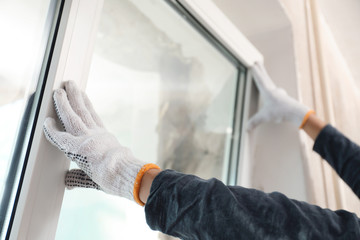Window and Door – Choosing Window and Door Styles
Covering the residential fenestration industry, Long Island Window and Door connects manufacturers with their dealer network. It delivers unbiased, relevant content to help the industry grow.
Consumers remain highly motivated to bring the outdoors inside, driving a demand for larger windows and patio doors. At the same time, performance desires are as strong as ever, particularly for energy efficiency.
The materials that are used in window and door manufacturing have a significant impact on the quality of the finished product. Whether you’re building a heritage restoration or constructing a sleek modern edifice, understanding the strengths, weaknesses and best applications for each material will ensure that your new windows align with your design aspirations and practical needs.
Steel windows are renowned for their strength and durability, especially when combined with a thermal break to improve energy efficiency. In a world where carbon emissions continue to be a major contributor to climate change, steel is a sustainable option for homeowners, builders and architects. Made with recycled and recyclable steel, steel windows are impervious to air and water infiltration and help achieve LEED certification in the built environment.
Aluminium is also a versatile choice for both commercial and residential projects. Its lightweight and durable properties allow narrower frames to be created, allowing natural light to fill interior spaces more easily. It can be coloured with durable paints to match the aesthetic of any property, and it is very strong despite its thin profile. However, aluminium conducts heat, so it’s not as insulating as other materials, and it is susceptible to corrosion and condensation.
uPVC (unplasticised polyvinyl chloride) is a hardwearing and energy efficient material. It is naturally warm, easy to clean and highly resistant to chipping and splitting. uPVC is also non-conductive and doesn’t promote the formation of condensation on frames. It’s an ideal choice for high-rise buildings as it is highly resistant to wind load and offers exceptional strength and stability.
Wood is a timeless and classic option for those seeking a more traditional look. It’s a natural insulator, and it’s possible to choose from a range of softwoods with beautiful grain patterns, or even Accoya – a sustainably-sourced timber that undergoes a treatment process to increase durability and insulating properties.
For more contemporary designs, composite frames offer the insulating benefits of wood with the strength and stability of aluminum. They’re available in a wide variety of finishes to mimic the appearance of wood, and they can be customised with different operational options and colours.
Styles
Whether you are building a new home or replacing windows in an existing property, the style of window and door you choose will have a significant impact on your home’s design theme, comfort level and energy efficiency. The best place to start when choosing window and door styles is to understand the different options that are available.
Window and door styles range from basic square and rectangular shapes to rounded or curved lines and bay windows. Some styles are mulled together to create larger spans and others are designed to work well with a specific architectural design.
The style you choose will also influence how easy the window is to clean. Double hung windows tilt the sash in, while sliders lift and slide open, making cleaning both interior and exterior surfaces much easier. Casement windows, on the other hand, open outward and require a little more effort to reach, but they provide excellent ventilation.
If you have chosen a Craftsman style house or another architecturally authentic style, it is important to select front doors and window styles that work with the overall look of your home. This can be a challenge, but the right choice will blend seamlessly to make a beautiful home that also functions the way you want it to.
When working with a more contemporary home, it is usually preferable to use larger glass openings that let in plenty of light while creating a seamless connection between indoor and outdoor spaces. Sliding windows are a popular choice for this type of home, but casements and awning windows also work very well.
Window and door hardware also has a significant impact on the look of a home. Wood offers a rich appearance, aluminum is sleek and modern and vinyl provides a cost-effective option that is very durable. You can also choose from a variety of finishes for the hardware. For example, brushed nickel is a popular choice for window handles, but other colors may be more appropriate depending on the style of your home.
Energy Efficiency
One of the biggest benefits of energy-efficient windows and doors is that they save on energy usage, reducing utility costs and cutting down on carbon dioxide emissions. They also reduce wear and tear on heating and cooling systems, prolonging their lifespans. Moreover, they minimize noise pollution from outside, creating a peaceful home environment and making it easier to focus on daily tasks.
The main way that energy-efficient windows cut down on energy use is by insulating better, keeping the indoor temperature steady throughout the year and minimizing heat transfer. They also help prevent harmful UV rays from entering the house, protecting interior furnishings and fabrics from discoloration and fading.
Most importantly, they can reduce reliance on artificial lighting and HVAC systems, which in turn cuts down on electricity bills. They are also a good investment, with resale value increasing as buyers seek out homes with lower operating expenses and green upgrades.
Energy efficiency is largely achieved through multi-pane designs, improved coatings, and multiple sealing points. Double- and triple-pane windows, for instance, insulate better than single-pane options because they allow more sunlight to penetrate the home, reducing the need for artificial lighting. In addition, the National Fenestration Rating Council offers ratings that examine the performance of entire windows, ensuring a comprehensive assessment and comparison of products. Look for ENERGY STAR certification and check the U-factor and solar heat gain coefficient (SHGC), with lower numbers indicating greater efficiency.
In addition, the use of low-emissivity (Low-E) glass, which has a microscopic layer that reflects thermal energy rather than absorbs it, significantly reduces the amount of unwanted UV rays and heat that enters a building. Lastly, the use of vinyl frames sealed with Intercept Warm Edge Spacer, a foam insulation that insulates the exterior edges of a window, can tack on additional savings.
Choosing energy efficient windows and doors is easy with the expert advice and top-quality products at Silverline Exterior Solutions. We offer an extensive selection of energy-efficient options to fit your taste, style, and budget. You can also count on our installation services to ensure superior results and long-term energy savings. Call us today to learn more about how we can boost your home’s efficiency and comfort!
Security
Whether in residential or commercial settings, windows and doors serve as the initial line of defence against unwanted intruders. Therefore, they must be built to withstand a wide variety of threats.
This is why many of today’s window and door manufacturers are constantly seeking out ways to improve their products’ security capabilities without compromising on aesthetics. From incorporating more secure locks to using advanced glass with reinforced inlays, there are plenty of strategies to keep your property and its occupants safe from potential break-ins.
The main way to increase the security of a window or door is through the use of sensor technologies. These devices typically consist of a sensor installed on the window or door frame and a magnet installed on the corresponding moving part (window or door). The installer must carefully align these components so that they “contact” properly when closed, which indicates that the window or door is locked. When the contact is broken, the sensors will notify Cove that the window or door has been opened and the system will trigger an alarm.
Another way to enhance the security of your doors and windows is by using laminated or impact-resistant glass. These types of glass utilise multiple layers with a polyvinyl butyral (PVB) interlayer to help hold the glass together, making it difficult for intruders to break through. They also offer superior sound absorption, reducing the risk of injury from shattered glass.
Other upgrades that can be made to improve the security of your windows and doors include hinge bolts and acoustic glassbreak detection capabilities. The former is a simple, cost-effective solution that provides additional protection against physical break-ins by preventing the hinge pin from lifting off of the hinges. The latter is an advanced option that combines the benefits of acoustic glassbreak detection with shock-sensing capabilities to provide double protection against literal break-ins.
Windows and doors with higher security ratings are not only better suited to withstand break-ins but may also be more favourable in terms of insurer coverage. This makes them a great investment for those looking to improve the safety of their homes or workplaces.

